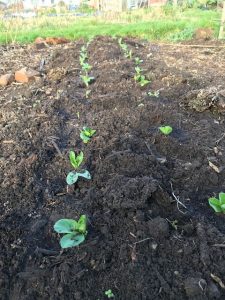Wilding by Isabella Tree
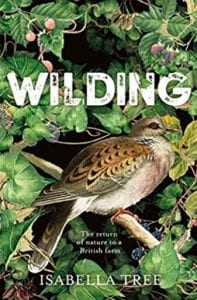 A volunteer who works with me on the wildlife plot suggested I read Wilding: The return of nature to a British farm by Isabella Tree. I hadn’t heard of this book but it was highly commended by the 2019 Wainwright Book Prize and so there is no time like the present to get started on it.
A volunteer who works with me on the wildlife plot suggested I read Wilding: The return of nature to a British farm by Isabella Tree. I hadn’t heard of this book but it was highly commended by the 2019 Wainwright Book Prize and so there is no time like the present to get started on it.
It is a fantastic story about wilding the Knepp Estate, a mixed farm, which through grants and lack of money became the most amazing return to nature with a little help from the owners. The one thing the book does really well is show the inter-connectedness of everything. So, rather than write the normal sort of review, I am going to record some of the elements which were new to me or amazed me.
- I didn’t know about the relationship between oak trees and jays. Jays eat acorns but also store them. They peck and push them far down into the soil – in fact to the very distance that is most propitious for an acorn to sprout. During the summer months they leave the acorns as there is plenty of other food but then eventually return. By now the acorn has sprouted so the jay pulls it up just enough to get to the cotyledon leaves which remain underground. Because the oak sends down strong roots very early in its life, it is often strong enough to withstand this attack and will carry on growing. If that isn’t enough, the jay will bury the acorns at the edge of scrub plants and these continue to grow and eventually provide a thorny tree guard for the oak, preventing cows, deer and other grazing animals getting to it. So, not only does the jay get a carbohydrate rich food, but it plants the seeds from which the next oaks will grow. In a four week period a jay can bury about 7,500 acorns. Why aren’t we allowing jays to do this for us instead of recruiting hundreds of volunteers to plant trees that need plastic guards?
- By not using herbcides, pesticides and any other cide on the farm the number and type of dung beetles increased dramatically. In fact the owners timed how long it took for beetles to arrive at a newly deposited pile of dung and it was three minutes. Using wormers and paratiscides on cattle kills the dung beetles or any other insect that eats the dung. Because dung beetles tunnel, this has an impact on the quality of the soil reducing the aeration, fertility and ability to soak up water. But even better, the dung beetles reduce the parasites in the dung by eating it up quickly and therefore reduce the amount of wormers needed. And of course, if you use wormers, it reduces the beetles and other insects which then has an effect on the birds and so on up through the food chain.
- Honeysuckle provides nesting material for doormice. I didn’t know that and we don’t really have any, honeysuckle or doormice, on the wildlife plot so need to take some cuttings and grow some if only for the scent.
-

Credit – Getty images
What comes through loud and clear in the book is something Tree refers to as ‘species-shifting syndrome’ as exemplified by nightingales and purple emperor butterflies. Nightingales are often referred to as a woodland species but left to their own devices at Knepp, the nightingales have nested in wide, prickly hedges and open-grown scrub both of which are rich in insects, not woodland. Could it be that they are seen in coppiced woodland because they are clinging on to a habitat that is present, not their preferred but the least worst thing. Time and again, Tree says that if you look in wildlife guides over a 100 years ago the range and type of habitat described in them is different to the modern guides. If we take the modern guides at face value we would be planting lots of coppiced woodlands to encourage nightingales but it wouldn’t. They cling on to these as a last hope not actively choosing them as their preferred habitat. She demonstrates the same with the butterflies and suspects the same thing with collared doves.
- If you want to increase biodiversity allow herbivores on the land. They create a biodiverse ecosystem from a blank slate – just one species will do but if you have more then there will be an even bigger effect. One example given in the book is in Nigeria where cattle grazed with donkey’s put on 60% more weight because the donkeys graze the tough, upper portion of the grass revealing more delicate parts for cows. This also happens slightly closer to home on Dartmoor where the wild ponies eat what they like, leaving close cropped grass for other herbivores such as free-roaming cattle and sheep. What they leave behind is ideal habitat for marsh fritillary butterflies.
- Islands of wilding are not enough. We need corridors and more, bigger and better sites.
This is such a fantastic book, jam-packed full of interesting, slowly evolving rewilding observations. The big take away from it is that nature does it best; not the big, well-known conservation groups although they have all done other good things. It is their lack of ability to take risks and to be at the forefront of different ways of working that is quite frustrating.
All I can say is the winning book of the Wainwright prize in 2018 must have been excellent.
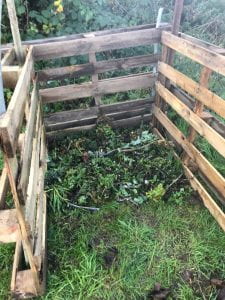 This post is part of my trial to build an 18 day compost heap each month of the year to see what happens – I wasn’t sure that it would work during the winter as the videos I had seen were made in Australia and other much hotter countries than the UK. You can see
This post is part of my trial to build an 18 day compost heap each month of the year to see what happens – I wasn’t sure that it would work during the winter as the videos I had seen were made in Australia and other much hotter countries than the UK. You can see 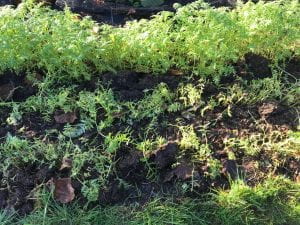 I can see why it is suggested that you have all your manure, brown and green materials and water at hand when you build the pile. I must have walked 10,000 steps getting everything in place as I built the heap; a lesson for January! I did mark out the size of the heap with pallets this time but realised after I had lugged them around that I could just use 4 poles pushed into the earth next time. Anyway, as I built the heap I also found that I didn’t have enough green material and so needed to cut down a bed of phacelia that I had sown at the beginning of October. I had originally planned for this to flower in the spring and then cut it down because it was sown on a bed that had had strawberries for about 5 years and the bed needs a serious bit of work on the soil. I also managed to find a few comfrey leaves to add to the pile to kick start the process and I wetted the materials a LOT more than last time.
I can see why it is suggested that you have all your manure, brown and green materials and water at hand when you build the pile. I must have walked 10,000 steps getting everything in place as I built the heap; a lesson for January! I did mark out the size of the heap with pallets this time but realised after I had lugged them around that I could just use 4 poles pushed into the earth next time. Anyway, as I built the heap I also found that I didn’t have enough green material and so needed to cut down a bed of phacelia that I had sown at the beginning of October. I had originally planned for this to flower in the spring and then cut it down because it was sown on a bed that had had strawberries for about 5 years and the bed needs a serious bit of work on the soil. I also managed to find a few comfrey leaves to add to the pile to kick start the process and I wetted the materials a LOT more than last time.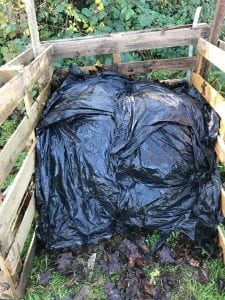 The pile is as big as I can make it and it is still not a cubic meter. The limiting factors at this time of the year are green materials and if I am to make a pile in January, I am going to have to go out on a scavenge. I spotted some younger nettles and weeds on the way into the plots yesterday so will harvest them over the next few days to start my January pile.
The pile is as big as I can make it and it is still not a cubic meter. The limiting factors at this time of the year are green materials and if I am to make a pile in January, I am going to have to go out on a scavenge. I spotted some younger nettles and weeds on the way into the plots yesterday so will harvest them over the next few days to start my January pile.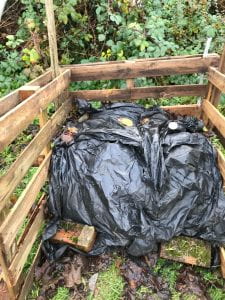
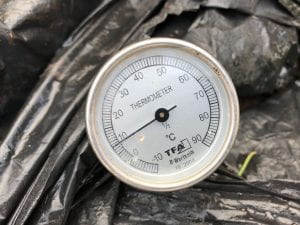
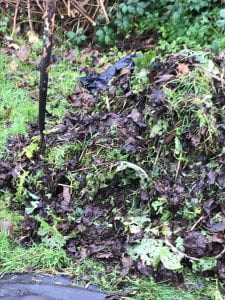

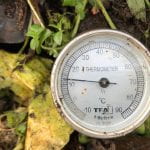
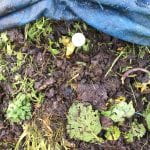

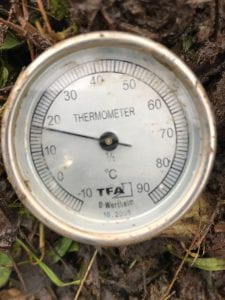
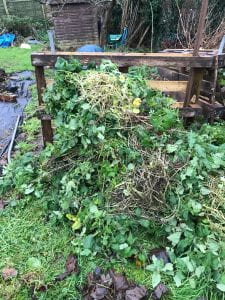
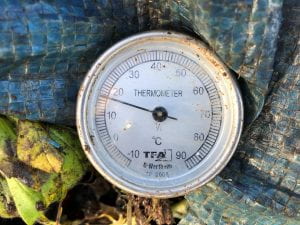 The weather was so bad on the 18th – 30mm of rain throughout the day – that I couldn’t/didn’t want to go down to the allotment so the turn of the pile was 1 day later. You can no longer identify the phacelia but the weeds which were not ripped up are still visible as is all the brown stuff although all are much more mixed up now. The pile is wet enough because the tarpaulin is woven and quite a bit of rain from yesterday go through.
The weather was so bad on the 18th – 30mm of rain throughout the day – that I couldn’t/didn’t want to go down to the allotment so the turn of the pile was 1 day later. You can no longer identify the phacelia but the weeds which were not ripped up are still visible as is all the brown stuff although all are much more mixed up now. The pile is wet enough because the tarpaulin is woven and quite a bit of rain from yesterday go through.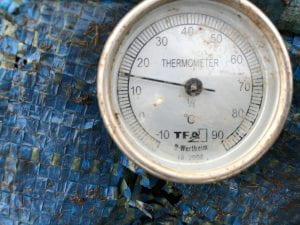

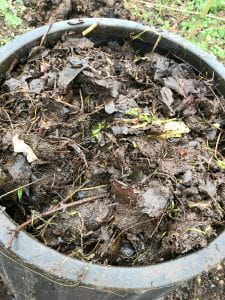
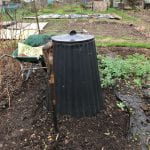
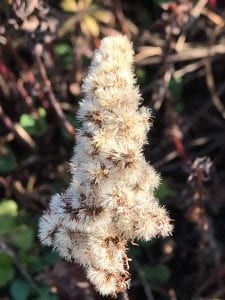
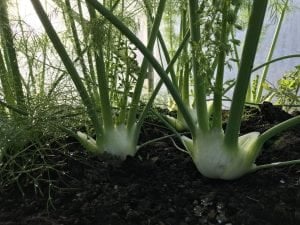 The fennel in the polytunnel is ready to provide a crisp aniseed flavour to the winter salads over the next few months. It is one of the few vegetables I have managed to grow throughout the year. Spring’s fennel is on the other side of the tunnel and still quite small.
The fennel in the polytunnel is ready to provide a crisp aniseed flavour to the winter salads over the next few months. It is one of the few vegetables I have managed to grow throughout the year. Spring’s fennel is on the other side of the tunnel and still quite small.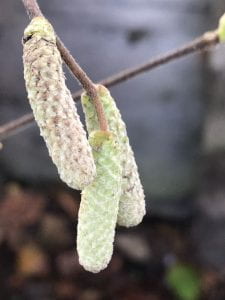 The catkins are already out on the hazels, dangling in the sunshine and these have survived the massive coppicing that we did at the start of the month.
The catkins are already out on the hazels, dangling in the sunshine and these have survived the massive coppicing that we did at the start of the month.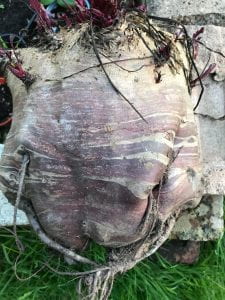 This massive beetroot is still lying around and I was right that it wouldn’t make good eating because not even the slugs and snails have started on it. I didn’t aim for massive beetroot, I just wanted to save some seed and this grew.
This massive beetroot is still lying around and I was right that it wouldn’t make good eating because not even the slugs and snails have started on it. I didn’t aim for massive beetroot, I just wanted to save some seed and this grew.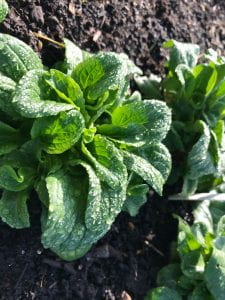 And finally, lambs lettuce as a filler for my salads. I actually managed to plant these early enough for them to grow to a reasonable size before it got too cold.
And finally, lambs lettuce as a filler for my salads. I actually managed to plant these early enough for them to grow to a reasonable size before it got too cold. First off are the parsnips. I generally have dreadful troubles with germination and this year was no different. However, an allotment neighbour had sown his and they had all germinated in the early warm weather we had this year. True to form, it took me 3 goes to get some germination. These are Countess and I will grow them again next year. They are enormous. In fact, I could sow some each month so that I have more of them but not all this size!
First off are the parsnips. I generally have dreadful troubles with germination and this year was no different. However, an allotment neighbour had sown his and they had all germinated in the early warm weather we had this year. True to form, it took me 3 goes to get some germination. These are Countess and I will grow them again next year. They are enormous. In fact, I could sow some each month so that I have more of them but not all this size!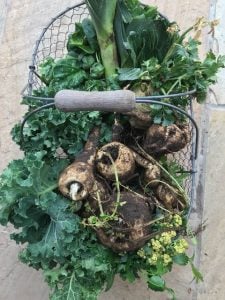
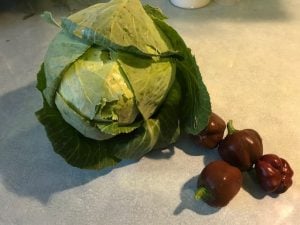
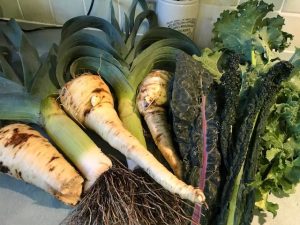
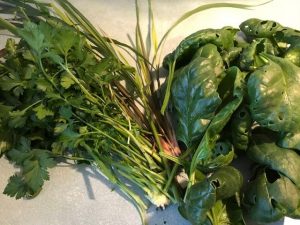 And finally there are the herbs and spinach again from the polytunnel. The flat-leaved parsley grows all winter here and with 5 plants, I have enough to see me through until late spring. There is also some lemon grass in here which I grew from seed. I use it in a raw carrot, ginger and lemon salad which is one of those fresh dishes that you sometimes crave during winter. The spinach is just a small handful now and will sit there until spring when it starts growing again.
And finally there are the herbs and spinach again from the polytunnel. The flat-leaved parsley grows all winter here and with 5 plants, I have enough to see me through until late spring. There is also some lemon grass in here which I grew from seed. I use it in a raw carrot, ginger and lemon salad which is one of those fresh dishes that you sometimes crave during winter. The spinach is just a small handful now and will sit there until spring when it starts growing again.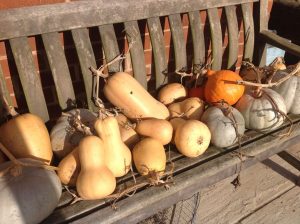 variety otherwise it will be a long winter. My favourite meal is a lamb and squash tagine. You can find the recipe below.
variety otherwise it will be a long winter. My favourite meal is a lamb and squash tagine. You can find the recipe below.
